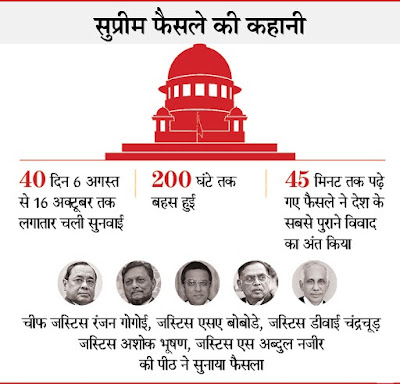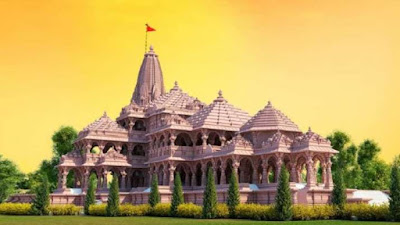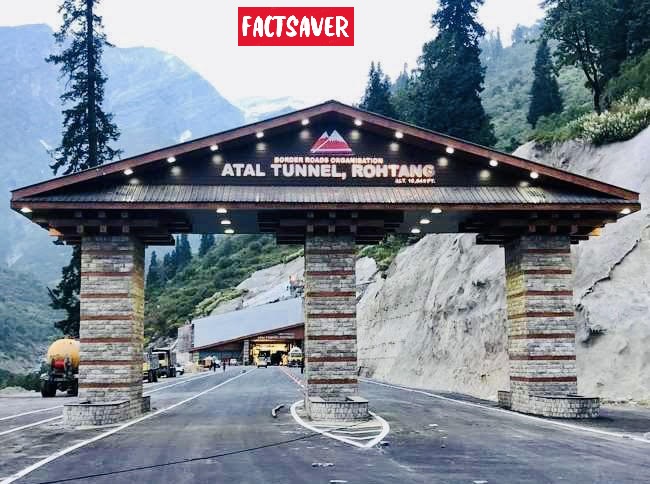Ram temple is going to be built again in Ayodhya after 492 years. On Wednesday, Prime Minister Narendra Modi started this by worshiping the land. At the same time, this will be the second time after 30 years, 8 months and 27 days, when the foundation stone will be for the Ram temple.
The story of a long legal battle, the biggest story of the biggest controversy, the story of faith, the story of conflict, the story of coincidences and the story of the victory of justice. Know all these stories here in this blog.
Full story of 492 years of major milestones...
1528: Babar's Subedar Mirbaki built a mosque in Ayodhya. It was named Babri Masjid in honor of Babar.
1853: Communal violence erupted in Ayodhya for the first time during the Nawab of Awadh, Wajid Ali Shah. The Hindu community said that the mosque was built by breaking the temple.
1885: Mahant Raghubar Das petitioned Faizabad District Court to build a temple on Ram Janmabhoomi. The court quashed the petition.
1949: A statue of Ramlala is installed under the Central Dome at the disputed site. FIR was registered in the case. The campus gate was locked.
1950: Hindu Mahasabha's counsel Gopal Visharad and Paramhans Ramchandra Das filed an application in the Faizabad district court seeking the right to worship the idol of Ramlala.
1959: Nirmohi Akhara asserts ownership over the disputed site.
1961: The Sunni Waqf Board (Central) petitioned the court against the installation of the idol and asserted its right to the mosque and the surrounding land.
1981: Uttar Pradesh Sunni Central Waqf Board sues for land ownership.
April 8, 1984: A huge Dharma Sansad was also organized for the construction of Ram temple at Vigyan Bhawan, Delhi.
1986: The local court granted permission to open the lock of the premises for worship. This sparked controversy.
1989: On July 1, retired judge Devki Nandan Aggarwal filed a petition in Faizabad court as a friend of Ram.
1989: Allahabad High Court asked to maintain status quo at disputed site.
9 November 1989: The foundation stone of the temple was laid, Kameshwar Chaupal of the Dalit community laid the first brick. Kameshwar is now a member of the Sri Ram Janmabhoomi Tirtha Kshetra Trust.
1990: LK Advani started the Rath Yatra to garner support for the Ram temple from across the country.
1992: The disputed structure was demolished in Ayodhya on 6 December.
1993: The Center annexed 67.7 acres of land surrounding the disputed area.
1994: Hearing a petition against the decision of the Center, the Supreme Court said that Namaz can be read anywhere in Islam. It is not necessary to have a mosque for this.
2002: Allahabad High Court starts hearing on petitions filed for the ownership of disputed land.
2003: Supreme Court prohibits any religious activity in the disputed area. The Archaeological Survey of India submitted its report. In it, there was talk of an old structure at the disputed site.
2009: The Liberhan Commission recommended action on 68 people in its report. It had names of big BJP leaders like Atal Bihari Vajpayee, Lal Krishna Advani, Murali Manohar Joshi.
2010: The Allahabad High Court ruled 2: 1 and divided the disputed site equally between the Sunni Waqf Board, Nirmohi Akhara and Ramlala in three parts.
2011: The Supreme Court stayed the Allahabad High Court verdict.
2016: Subrahmanyam Swamy filed an application in the Supreme Court seeking permission to build the Ram temple at the disputed site.
2017: Supreme Court Chief Justice JS Khehar suggested to settle the case outside the court.
2018: Supreme Court begins hearing on various petitions filed regarding Ayodhya dispute.
January 2019: Supreme Court set up a 5-judge bench headed by Chief Justice Ranjan Gogoi to hear the case.
6 August 2019: The Constitution Bench of the Supreme Court begins hearing on appeals of the Hindu and Muslim side filed against the Allahabad High Court's decision.
16 October 2019: Hearing of the case completed in the Supreme Court.
9 November 2019: The Supreme Court considered the right of Ramlala to sit on the disputed land.
Hindi
- 1528 : बाबर के सूबेदार मीरबाकी ने अयोध्या में मस्जिद बनवाई। बाबर के सम्मान में इसे बाबरी मस्जिद नाम दिया गया।
- 1853 : अवध के नवाब वाजिद अली शाह के समय पहली बार अयोध्या में सांप्रदायिक हिंसा भड़की। हिंदू समुदाय ने कहा कि मंदिर तोड़कर मस्जिद बनाई गई।
- 1885: महंत रघुबर दास ने फैजाबाद डिस्ट्रिक्ट कोर्ट में राम जन्मभूमि पर मंदिर बनाने के लिए याचिका लगाई। कोर्ट ने याचिका रद्द कर दी।
- 1949 : विवादित स्थल पर सेंट्रल डोम के नीचे रामलला की मूर्ति स्थापित की गई। मामले में एफआईआर हुई। परिसर का गेट लॉक कर दिया गया।
- 1950 : हिंदू महासभा के वकील गोपाल विशारद और परमहंस रामचंद्र दास ने फैजाबाद जिला अदालत में अर्जी दाखिल कर रामलला की मूर्ति की पूजा का अधिकार देने की मांग की।
- 1959 : निर्मोही अखाड़े ने विवादित स्थल पर मालिकाना हक जताया।
- 1961 : सुन्नी वक्फ बोर्ड (सेंट्रल) ने मूर्ति स्थापित किए जाने के खिलाफ कोर्ट में अर्जी लगाई और मस्जिद व आसपास की जमीन पर अपना हक जताया।
- 1981 : उत्तर प्रदेश सुन्नी सेंट्रल वक्फ बोर्ड ने जमीन के मालिकाना हक के लिए मुकदमा दायर किया।
- 8 अप्रैल 1984: दिल्ली के विज्ञान भवन में राम मंदिर निर्माण के लिए एक विशाल धर्म संसद का भी आयोजन किया गया।
- 1986: लोकल कोर्ट ने पूजा के लिए परिसर का लॉक खोलने की अनुमति दी। इससे विवाद को हवा मिली।
- 1989: एक जुलाई को रिटायर्ड जज देवकी नंदन अग्रवाल ने फैजाबाद कोर्ट में राम के मित्र के रूप में याचिका लगाई।
- 1989 : इलाहाबाद हाईकोर्ट ने विवादित स्थल पर यथास्थिति बरकरार रखने को कहा।
- 9 नवंबर 1989: मंदिर का शिलान्यास हुआ, दलित समुदाय के कामेश्वर चौपाल ने पहली ईंट रखी। कामेश्वर अब श्रीराम जन्मभूमि तीर्थ क्षेत्र ट्रस्ट के सदस्य हैं।
- 1990: लालकृष्ण आडवाणी ने देशभर से राम मंदिर के लिए समर्थन जुटाने के लिए रथ यात्रा शुरू की।
- 1992 : 6 दिसंबर को अयोध्या में विवादित ढांचा ढहा दिया गया।
- 1993: केंद्र ने विवादित इलाके के आसपास के 67.7 एकड़ इलाके को अपने कब्जे में ले लिया।
- 1994: केंद्र के फैसले के खिलाफ लगी एक याचिका पर सुनवाई करते हुए सुप्रीम कोर्ट ने कहा कि इस्लाम में नमाज कहीं भी पढ़ी जा सकती है। इसके लिए मस्जिद का होना जरूरी नहीं है।
- 2002 : इलाहाबाद हाईकोर्ट ने विवादित ढांचे वाली जमीन के मालिकाना हक को लेकर दायर याचिकाओं पर सुनवाई शुरू की।
- 2003: सुप्रीम कोर्ट ने विवादित क्षेत्र में किसी भी तरह की धार्मिक गतिविधि पर रोक लगाई। आर्कोलियॉजिकल सर्वे ऑफ इंडिया ने अपनी रिपोर्ट जमा की। इसमें विवादित जगह पर किसी पुराने ढांचे के होने की बात की गई।
- 2009: लिब्राहन आयोग ने अपनी रिपोर्ट में 68 लोगों पर कार्रवाई की सिफारिश की। इसमें अटल बिहारी वाजपेयी, लाल कृष्ण आडवाणी, मुरली मनोहर जोशी जैसे बड़े भाजपा नेताओं के नाम थे।
- 2010 : इलाहाबाद हाईकोर्ट ने 2:1 से फैसला दिया और विवादित स्थल को सुन्नी वक्फ बोर्ड, निर्मोही अखाड़ा और रामलला के बीच तीन हिस्सों में बराबर बांट दिया।
- 2011 : सुप्रीम कोर्ट ने इलाहाबाद हाईकोर्ट के फैसले पर रोक लगाई।
- 2016 : सुब्रह्मण्यम स्वामी ने सुप्रीम कोर्ट में अर्जी दायर कर विवादित स्थल पर राम मंदिर के निर्माण की इजाजत मांगी।
- 2017: सुप्रीम कोर्ट के चीफ जस्टिस जेएस खेहर ने कोर्ट के बाहर मामला सुलझाने की सुझाव दिया।
- 2018 : सुप्रीम कोर्ट ने अयोध्या विवाद को लेकर दाखिल विभिन्न याचिकाओं पर सुनवाई शुरू की।
- जनवरी 2019: सुप्रीम कोर्ट ने केस की सुनवाई के लिए चीफ जस्टिस रंजन गोगोई की अध्यक्षता में 5 जजों की बेंच बनाई।
- 6 अगस्त 2019 : सुप्रीम कोर्ट की संविधान पीठ ने इलाहाबाद हाईकोर्ट के फैसले के खिलाफ दायर हिंदू और मुस्लिम पक्ष की अपीलों पर सुनवाई शुरू की।
- 16 अक्टूबर 2019 : सुप्रीम कोर्ट में मामले की सुनवाई पूरी हुई।
- 9 नवंबर 2019: सुप्रीम कोर्ट ने विवादित जमीन पर रामलला विराजमान का हक माना।











0 Comments